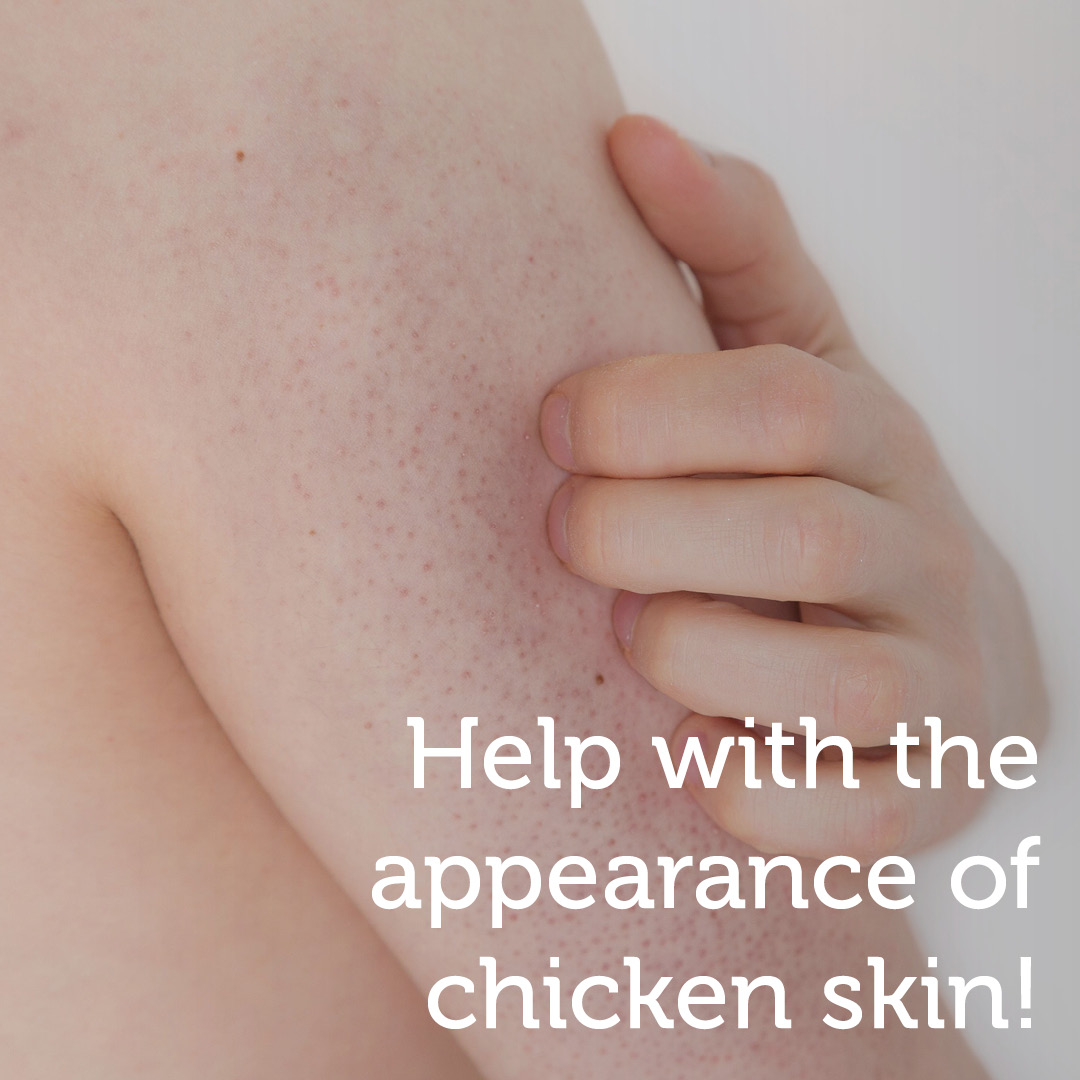28 Sep The Truth about Keratosis Pilaris

Lumpy, bumpy limbs are not just the preserve of oven-ready poultry. ‘Chicken Skin’, keratosis pilaris affects as many as 1 in 3 of us1.
It tends to run in families and although it’s harmless, it can be unsightly. Unfortunately, there’s still no cure available but there are plenty of things you can do to smooth your skin and improve the appearance.
What causes chicken skin?
The rough, ‘goose-bump’ like rash on the outer parts of your body, such as your upper-arms, has a scientific name; it’s called keratosis pilaris (KP). This is caused by too much of the body’s protein keratin blocking the hair follicles. This blockage in the follicle leads to small lumps appearing. The bumps are usually the same colour as your normal skin, but they may become a little red and inflamed. If you stroke the skin, it feels rough and uneven to the touch2.
Who gets Keratosis Pilaris?
KP is a common problem. Research shows that it affects nearly 50-80% of all adolescents and around four in ten of adults3. It’s caused by a dominant, faulty gene, which is passed down from parent to child. You have a one in two chance of inheriting the abnormal gene from one parent and developing KP4.
Keratosis Pilaris (KP) is more common in people with dry skin conditions, eczema and atopy as well as in people who are obese5. The good news is that KP is usually very mild, in fact many people barely notice the skin changes. However, some people find the look of their skin makes them uncomfortable and self-conscious4.
How can you treat keratosis pilaris
There is no cure for KP, but it does often clear up during adult life6. It’s also at its worst when your skin is dry, especially in winter months. You can help to improve the look and feel of your skin by following some basic guidelines:
- Choose lukewarm showers and baths instead of hot showers or baths. Long, lazy soaks or showers in hot water can dry out your skin and make KP worse7.
- Apply emollients frequently. Slather on moisturiser to help the skin retain water and protect against moisture loss. Regular use can help soften the skin and may improve the appearance. Emollients are more effective when applied to damp skin straight after bathing or showering, so keep a tube in the bathroom.
- Use soap substitutes. Soap and harsh cleaning chemicals can strip the skin of natural oils7. Always use soap-free products for a gentler cleanse.

- Exfoliate gently. Don’t scrub your skin, you’ll make it sore, red and inflamed. However, the gentle removal of dead skin cells may improve the appearance of KP and smooth the surface of the skin. Creams containing the active ingredients salicylic acid, lactic acid or urea can each make more of a difference than emollients alone. These treatments can be bought over-the-counter, so chat to your local pharmacist or see your doctor for a prescription or a recommendation7.
- Keep it simple. Avoid products containing chemicals which may sensitise the skin. The AproDerm® range has been scientifically formulated to be free from SLS, parabens, halogens, fragrances, alcohol and colours, these additives can irritate already sensitive skin.
- Expert help. Further treatments are unlikely to be available on the NHS and would require specialist or cosmetic clinic assessment. Topical steroid creams, stronger retinoid treatments, laser resurfacing, peels, dermabrasion and photodynamic therapy are all used privately, although it is important to emphasise that none of these have been shown to cure the condition6.
It’s all about being kind to your skin and stopping it drying out. With a little consistent care, your skin will be ready for days on the beach and skimpy clothes by the time summer comes around.
1 Skinsupport.org.uk. (2014). Keratosis pilaris | Skin Support. [online] Available at:http://www.skinsupport.org.uk/conditions-details/keratosis-pilaris [Accessed 27 Sep. 2018]| 2 Martin, L. (2016). Keratosis Pilaris. [online] WebMD. Available at:https://www.webmd.com/skin-problems-and-treatments/keratosis-pilaris#1 [Accessed 27 Sep. 2018].| 3 Alai, A. and Elston, D. (2018). Keratosis Pilaris: Background, Pathophysiology, Epidemiology. Emedicine.medscape.com [Accessed 27 Sep. 2018]| 4 Britishskinfoundation.org.uk. (n.d.). Keratosis Pilaris. [online] Available at:http://www.britishskinfoundation.org.uk/SkinInformation/AtoZofSkindisease/KeratosisPilaris.aspx [Accessed 27 Sep. 2018]|5 Thomas, M. and Khopkar, U. (2012). Keratosis Pilaris Revisited: Is It More Than Just a Follicular Keratosis?. International Journal of Trichology, 4(4), p.255.|6 Bad.org.uk. (2017). British Association of Dermatologists – Patient Information Leaflets (PILs). [online] Available at: http://www.bad.org.uk/for-the-public/patient-information-leaflets/keratosis-pilaris/?showmore=1&returnlink=http%3a%2f%2fwww.bad.org.uk%2ffor-the-public%2fpatient-information-leaflets#.W6yaoPZFyzl [Accessed 27 Sep. 2018] |7 Simmons, S. (2016). Is Soap Bad For Your Skin?. [online] Bustle. Available at: https://www.bustle.com/articles/132760-is-soap-bad-for-your-skin-or-can-this-myth-be-debunked [Accessed 27 Sep. 2018]|



Sorry, the comment form is closed at this time.